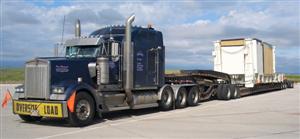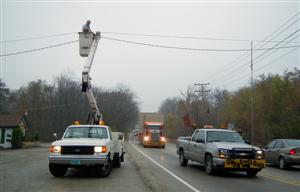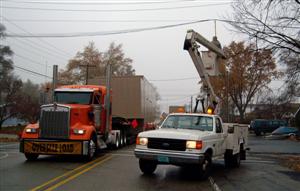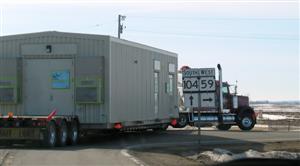JULY 2008 TRUCKER TALK
THE WORLD OF HEAVY HAULING
BY WRITER & OWNER OPERATOR KIM GRIMM
Recently I’ve had the opportunity to learn about the wonderfully complicated world of heavy hauling. There is so much more to it than putting up a couple of load locks, closing the shiny back doors and heading out down the road! I’ll be the first to admit that I thought I was a truck driver, but compared to what these guys and gals in the heavy haul business do, what I do is easy! I had no idea.
When the load you’re pulling is heavy, tall, wide and long (or maybe all four), there is a lot to do before you go down the road. The first thing to do is get the load loaded and secured. That sounds easy enough, but oversized loads can be extra challenging. You have to know the proper way to chain down whatever you’re hauling – like when to cross the chains and when not to – and if there are tires on your load, you have to accommodate for the extra flex that will occur in transit and check the chains often to make sure they are staying tight. But securing your load is not the only thing that you have to consider. Trip permits, routes, escorts and curfews are all important factors to consider when planning to move a big load.
 Before you do anything else, you have to make sure that you have the proper permits, state and local if they apply, to move an oversized or overweight load – and getting these permits can be a lengthy process. Sometimes, for the really big loads, permits need to be arranged a month or more in advance of the move. The routes you are required to take are on the permit and you had better stay on them or you take the chance of having the permit revoked, getting shut down and being forced to wait (and pay) for another permit. And, of course, there will be a fine to pay, too. When you get off the state road, you have to know if you need a local permit, and if you’re in a place like Los Angeles, you might need to get a permit from each town you are going to drive through.
Before you do anything else, you have to make sure that you have the proper permits, state and local if they apply, to move an oversized or overweight load – and getting these permits can be a lengthy process. Sometimes, for the really big loads, permits need to be arranged a month or more in advance of the move. The routes you are required to take are on the permit and you had better stay on them or you take the chance of having the permit revoked, getting shut down and being forced to wait (and pay) for another permit. And, of course, there will be a fine to pay, too. When you get off the state road, you have to know if you need a local permit, and if you’re in a place like Los Angeles, you might need to get a permit from each town you are going to drive through.
Some states no longer do the routing for you on their permits. These states are now requiring the company doing the move to do a route survey, thus limiting their liability if something does go wrong along the way during the move. These surveys are costly and sometimes require weeks to complete. And when it’s done, that doesn’t always mean that the state can’t throw up some new construction within your pre-planned route that makes it no longer a viable plan. But you don’t want to find that out after you’ve started down the road with your large load. The time of year can also pose problems that you must consider when planning your route. In the spring, when there is frost, some states cut back the weight limits they will allow for an oversized load.
These days, with the “information superhighway” at all our fingertips, you would think that states would be able to have up-to-date construction zone information posted on a website so that people planning these routes for oversized loads could have reliable and current information, but that isn’t the case. A friend of mine was recently going across the state of Wyoming with an extra wide load, following the proper permit route, when he came upon construction on I-80 east of Rock Springs that wasn’t supposed to start until the following Monday. He made it through, but it took almost half an hour to go just a few miles. The sudden change was frustrating and unexpected, but he was lucky that he could still get through the area with his wide load.
Some of the states out there are very particular about your route plan. Nebraska is one state that will not allow an overweight load to cross an overpass over the interstate unless it is routed that way on your permit. So if you have to stop to rest or for fuel during your move, the truck stop or fuel location had better be on the same side of the interstate that you are traveling on! Who knew that there was so much to consider before even setting out with an oversized and/or overweight load – not me, that is for sure.
 Another thing to consider when planning your route is railroad crossings. Because of the low ground clearance on the trailers that pull these extra large loads, railroad tracks can be especially dangerous – sometimes the clearance is just a few inches. When planning your route, you must know if there will be any issues with rail crossings. On January 28, 2000 in Glendale, CA a fatal accident occurred when an oversized load got hung up on some railroad tracks when the driver tried to get back to the designated route on his permit. In this case, the load was being escorted by pilot cars and the CHP. In the end, the State of California ended up sharing part of the responsibility for this accident.
Another thing to consider when planning your route is railroad crossings. Because of the low ground clearance on the trailers that pull these extra large loads, railroad tracks can be especially dangerous – sometimes the clearance is just a few inches. When planning your route, you must know if there will be any issues with rail crossings. On January 28, 2000 in Glendale, CA a fatal accident occurred when an oversized load got hung up on some railroad tracks when the driver tried to get back to the designated route on his permit. In this case, the load was being escorted by pilot cars and the CHP. In the end, the State of California ended up sharing part of the responsibility for this accident.
Some jurisdictions require state patrol escorts when moving large loads. Off-duty officers volunteer to be escorts during their off-time hours and then are compensated by the company doing the move. We all see the escort cars in front of and/or behind oversized loads. They are there for a reason and it seems like that reason would be obvious, but just like someone saying, “I didn’t see the truck,” pilot cars can be ignored (or missed), too. I’ve always thought, if you can’t see something next to you that is as big as a truck when you are driving, maybe you shouldn’t be driving. And when you choose to “ignore” a pilot car assisting a truck with a big load, that’s just stupid – but people do it every day.
I recently had the chance to drive a pilot car for a short trip and found out that there is a lot to it. The truck driver is relying on the pilot car in front to give him information on what’s coming ahead and for assistance (blocking traffic and such) when he has to make a turn or cross a narrow bridge. And the driver of the pilot car behind the truck not only helps to warn oncoming vehicles to be cautious, but also has to assist with traffic control when necessary. If your load is high enough, the lead pilot car has a height pole. But that doesn’t always mean that an over-height load won’t end up stuck under an overpass. I always try to pay attention to the height signs on overpasses, and if it says 13’ 6” I slow down. But when your load is 15’ high or more, you’re playing a totally different ball game. If you get stuck under a bridge, guess what – you probably just bought that bridge. Talk about a high-priced claim: not only the messed up high-dollar load but also damages to state property. Oh boy!
The load in two of the pictures shown here was 16’ 2” high and was recently moved just a short distance within the state of Illinois. It took one day to load it, one day to move it and then one day to unload it. During the move, as seen in the photos, a bucket truck had to stay ahead of the orange Kenworth and an operator inside of the bucket had to actually lift electrical lines and telephone wires along the route so that the load could pass under them safely. Some loads require this on several occasions during a move. The really long loads even have a steerable trailer, meaning that the back can be steered remotely to help get around tight corners. It is just amazing how advanced some of this equipment, used to move this specialized freight, can be.
 The last major obstacle to overcome when planning an oversized or overweight move is time. Every state has it’s own times when it permits oversized loads to move. Some are half an hour before sunrise to half an hour after sunset; some are half an hour after sunrise to half an hour before sunset; and some are just sunrise to sunset. Most states do not allow oversized loads to move at night. Depending on what time of year it is will also dictate how many hours you can run – the trip can take a lot longer during the short days of winter when compared to the long days we have during the summer months. And then, just to make matters even more difficult, each city may have its own unique curfew which has to be accommodated. Most of the major cities have very narrow windows of time when permit loads are allowed to move through them (due to traffic concerns). And are all of the cities the same? Of course not!
The last major obstacle to overcome when planning an oversized or overweight move is time. Every state has it’s own times when it permits oversized loads to move. Some are half an hour before sunrise to half an hour after sunset; some are half an hour after sunrise to half an hour before sunset; and some are just sunrise to sunset. Most states do not allow oversized loads to move at night. Depending on what time of year it is will also dictate how many hours you can run – the trip can take a lot longer during the short days of winter when compared to the long days we have during the summer months. And then, just to make matters even more difficult, each city may have its own unique curfew which has to be accommodated. Most of the major cities have very narrow windows of time when permit loads are allowed to move through them (due to traffic concerns). And are all of the cities the same? Of course not!
What I now realize is that planning one of these trips involving “specialized” freight is a huge undertaking. And in addition to all of the other concerns mentioned before in this article, you also have to make sure that you can find a place to park at the end of the day, when truck stops are filling up early, that is large enough to accommodate your oversized load. You also need a powerful truck and a lot of special equipment. There really is a lot more to doing this kind of trucking and there is no school for it (maybe there should be). So, the next time you see one of these behemoth moves rolling down the highway, tip your hat and give them the space and respect they need to safely move that large load to its final destination.
